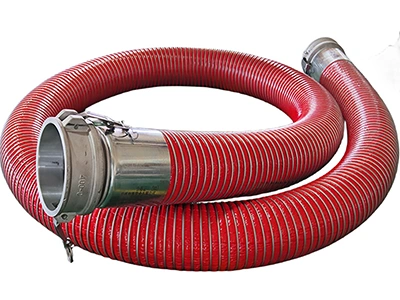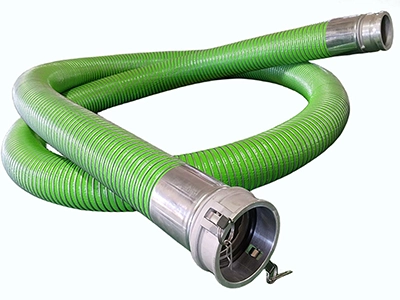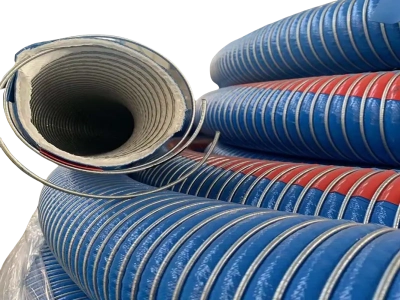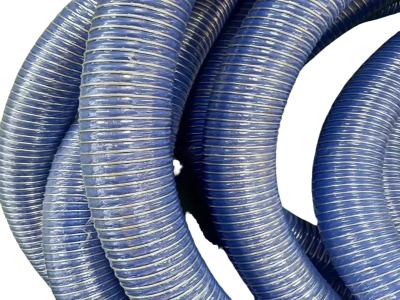Industrial composite hose is a kind of high performance delivery hose which is made of multi-layer materials and also includes two layer spiral metal wire on the inner and outer side. And also, such kind of multi layer structure become the most core advantage of composite hose. Each layer of composite hose separately caters to different performance requirements of customer, such as, corrosion resistance, good flexibility, high safety assurance and good mechanical strength. This kind of special structure makes composite hose has high temperature resistance and corrosion resistance, and also leads to its most ideal pipeline for transporting chemicals, petroleum, solvents, oil products, gases and other corrosive or flammable media.


Industrial composite hose usually composed of 5 to 10 layers of material, and these materials are made by a spiral winding process technology. Specifically including: Inner Lining Layer, Inner Spiral Steel Wire, Fabric Reinforcement Layer, Middle Composite Layer, Outer Spiral Steel Wire, and Outer Covering Layer. Each layer has its unique performance function.


The material of inner lining layer always to be: Polypropylene film (PP), Polytetrafluoroethylene (PTFE), Polyethylene (PE), Fluoroplastic (FEP/ETFE). Each layer has its unique performance target:
Polypropylene film (PP): usually used in acid, alkali, organic solvent application.
Polytetrafluoroethylene (PTFE): Almost inert, suitable for highly corrosive media
Polyethylene (PE): Resistant to weak acid and alkali, cost-effective
Fluoroplastic (FEP/ETFE): suitable for highly clean and high temperature environment
The inner lining layer of composite hose is the most direct contact structure with transfer medium, and it is the factor which decide composite hose’s chemical compatibility and interior cleanliness. The thickness of inner layer is usually to be 0.1-0.5mm, different thickness lead to different media resistance and softness.
The function of inner spiral wire is that, it supplies the flexible skeleton support to prevent inner layer from bending under negative pressure. The material selection of composite hose is always galvanized carbon steel wire, or stainless steel wire. Galvanized carbon steel wire is most common and its price is more lower than stainless steel wire. Galvanized carbon steel wire can satisfy most common transfer requirement which do not have special delivery require. Stainless steel wire is always used in highly corrosive environment or food grade environment. According to different scenarios, factory always select 304 stainless steel wire or 316 stainless steel wire. Price of stainless steel wire is higher than galvanized carbon steel. The wire diameter and pitch of inner spiral wire determines the stiffness, compression and bending properties of the industrial composite hose.
The fabric reinforcement layer of composite hose is located on the outside of the inner lining layer, and the material of fabric reinforcement layer always takes high strength polyester fiber cloth, and if the composite is under high pressure requirement, then the fabric reinforcement layer will take fragrant silk as the material. The function of fabric reinforcement layer is to improve the pressure resistance and tensile strength of composite hose, and to withstand pressure and tension during operation. The number of fabric reinforcement layer is generally 2-4 layers, these layers are wrapped in different directions, thus to improve the composite hose’ torsion resistance ability.
The location of the middle composite layer is on the outside of the fabric reinforcement layer. The middle composite layer is usually made of multi-layer anti-seepage membrane or reinforced membrane, PET/PE composite membrane. The function of middle composite layer is to further improve the chemical resistance, corrosion resistance, air tightness and mechanical isolation performance of the composite hose. The material selection of composite hose can change accord to customer’s actual require, and it can also add functional films such as antistatic layer and heat insulation layer. This kind of structure character constitutes the most significant characteristic and advantage of composite hose that distinguish them from their conveying hose.
Outer Spiral Steel Wire is located on the outermost layer of the composite hose. The material selection of outer spiral steel wire is usually to be galvanized carbon steel wire or stainless steel wire , which is the same material with inner spiral wire. Whether to choose galvanized carbon steel wire or stainless steel wire depends on customer’s specific application requirement. The exist of outer spiral steel wire is to improve the pressure resistance of composite hose and strengthening external protection. Meanwhile, the outer spiral steel wire can be connected to the grounding wire to achieve the anti-static function of the entire pipe. This design further enhances the multi-functional performance of the composite hose.
Outer Spiral Steel Wire is the outside structure of composite hose, and the material of it usually chooses Polyvinyl chloride (PVC), Thermoplastic polyurethane (TPU) and Polyester cloth coating. Among them, thermoplastic polyurethane (TPU) mainly provides wear resistance protection function. The color of outer covering layer is always produced by blue color, red color and yellow color, and it can usually be customized according to customer’s requirement. The function of outer covering layer is to protect composite’s hose’s inner structure part suffering from UV rays, prevent premature aging of composite hose and improve composite hose’s wear resistance ability. The outer covering layer can also be equipped with fire-retardant coating and metal woven mesh cover according to the customer's special requirement.
Composite Hose Structure Optimization
With the continuous development of modern technology, the manufacture process of composite hose is also developing in a more advanced and technological direction. The main optimization direction include the following aspects: